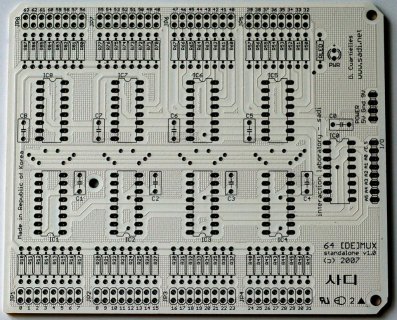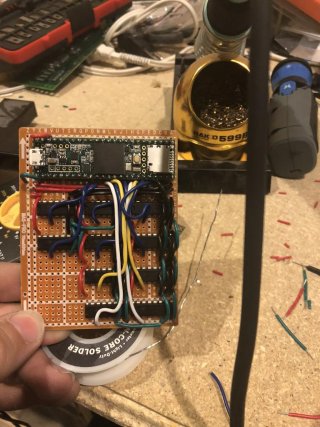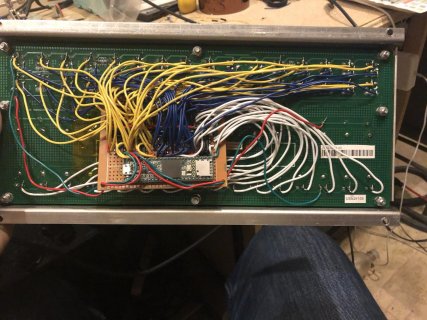AdmiralCrunch
Well-known member
Hi
I try to make my multi-mux-board to work reliable. First I wanted to ask what capacitors I would need to debounde the IC itself and then I found this here:

This board is exactly what I want to achieve, only mine has some more muxes.
One can see that there are not only capacitors between Vin and GND on the ICs, but also every IN of each IC has a Resistor connected between the IC-pin and the input-hole.
Now I have a couple of questions:
1) for what reason are there those resistors?
2) what values should those debouncing capacitors and the resistors have?
3) does it make a difference if some muxes poll analog and other digital signals?
4) in the middle between the two IC-rows, there is this horizontal lane with these holes ... is this A,B,C, INH ? .. if so, why are there so mane holes? and what could be the reason for placing them in the middle instead of outside like the other pin-holes?
5) on the power-pins on the right, it seems like there are two holes for GND.. as the whole GND-lane is thicker, can it be, that there are two cables with GND to connect here?
6) this pcb is for 8x 74HC4051, but there is a additional 4051 on the right, where the OUTs from the 8x 4051 are connected to.. is this a kind of "best practice"? .. my original plan was to connect all the OUTs directly to Teensy.
I try to make my multi-mux-board to work reliable. First I wanted to ask what capacitors I would need to debounde the IC itself and then I found this here:

This board is exactly what I want to achieve, only mine has some more muxes.
One can see that there are not only capacitors between Vin and GND on the ICs, but also every IN of each IC has a Resistor connected between the IC-pin and the input-hole.
Now I have a couple of questions:
1) for what reason are there those resistors?
2) what values should those debouncing capacitors and the resistors have?
3) does it make a difference if some muxes poll analog and other digital signals?
4) in the middle between the two IC-rows, there is this horizontal lane with these holes ... is this A,B,C, INH ? .. if so, why are there so mane holes? and what could be the reason for placing them in the middle instead of outside like the other pin-holes?
5) on the power-pins on the right, it seems like there are two holes for GND.. as the whole GND-lane is thicker, can it be, that there are two cables with GND to connect here?
6) this pcb is for 8x 74HC4051, but there is a additional 4051 on the right, where the OUTs from the 8x 4051 are connected to.. is this a kind of "best practice"? .. my original plan was to connect all the OUTs directly to Teensy.



